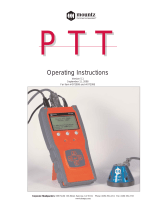EN
14
Sensotork 712
The tare of the torque is ascertained by pressing the
"Tare" button "MR".
Always ascertain the tare of the wrench, when, in
untensioned state, a value is shown which is
unacceptable for the accuracy.
After ascertaining the tare a value can remain
disparately at 0.00. This should stay within the
required accuracy of the adjusting parameters. If this
is not the case, then repeat the procedure to ascertain
the tare.
Sensotork 713
Ascertaining the torque tare is carried out in the same
way as the 712 model. When the "MR" button is
pressed, however, the rotational angle tare is
additionally ascertained.
The rotational angle value is automatically ascertained
when changing adjusting parameters as well.
Ascertaining the tare of the rotational angle can take
several seconds. During the process the display panel
shows "Tare".
Lay the switched-on torque wrench on a level
surface and hold it firmly.
Press the "MR" button.
The torque wrench now ascertains its tare.
Calling up adjusting operations and
define process
After all adjusting operations have been inputted, the
wrench is ready for operation.
The pre-defined adjusting operations and/or the define
process can be directly selected by means of the quick
selection facility using the "O" or "U" buttons ex-menu.
To call up the stored adjusting operations and/or
define process, press the "O" or "U" buttons
(quick selection facility).
All stored adjusting operations and/or define process
are shown as a list on the display panel.
Select the desired adjusting parameters and/or
define process.
Confirm the selection with the "MR" button.
The first adjusting parameters of a define process is
shown on the display panel.
To discontinue the selection, press the "ML"
button.
After the selection the desired adjusting parameters
and/or the first adjusting parameters of a define
process is activated.
In the 713 model the angle tare is now ascertained, if
a rotational angle adjusting parameters is activated.
Tightening
When carrying out adjusting parameters, apart from
displaying the torque and/or angle, the wrench will
give out further signals, which show the progress of
the adjusting parameters according to the preset
parameters.
While tightening, observe the torque values and/
or angle value indicated on the display panel.
Depending on the operating mode, the following
processes are possible:
Display
The display panel shows the current torque value.
The wrench reports no other occurrences, such as the
reaching of a threshold or barrier value.
DANGER
Danger of severe or fatal injuries due to
incorrect torque values caused by an
incomplete calibration process.
If a plug-in tool is contained in the
torque wrench, allow the plug-in tool to
project e.g. over the edge of a bench
during calibration.
Keep torque/angle-controlled wrench
713 steady throughout the entire
calibration process.
DANGER
Danger of severe or fatal injuries due to
an incorrect sequence when tightening
bolts.
Make sure that the bolts specified by the
sequence plan are tightened in the
relevant, correct sequence.
If you discover that you have confused
the sequence, abort the bolting process
immediately.
Loosen the bolt and use a new bolt if
necessary.
WARNING
Danger of severe injuries due to
overloading the torque wrench.
Do not load the torque wrench past the
maximum measuring range.
In the event of overload, both LEDs
flash, the handle vibrates and the
acoustic signal is sounded at intervals.
In this case, immediately abort the
bolting process.






















